The Great Roger Sherman
Roger Sherman (1722 – 1793) has the distinction of being the only man to sign the four significant founding documents of the USA.
And instead of having our Properties defended and secured to us by the Protection of the Government under which we live; we should be always exposed to have them taken from us by Fraud at the Pleasure of other Governments, who have no Right of Jurisdiction over us.
Roger Sherman
Despite the overarching program to cancel and malign our history, the events leading up to the birth of the United States form a remarkable study of human nature, philosophy, and noble struggle. The fascinating men and women of the era shine forth with figures such as George and Martha Washington, John and Abigail Adams, James and Dolly Madison, Benjamin Franklin, and many more.
It is an honor to introduce a Founding Father not as well known as the more prominent personalities: Roger Sherman (1722-1793). He has the distinction of being the only man to sign the four most important documents of our founding:
Articles of Association (1774) - First Continental Congress prohibited trade with Great Britain. Though it made a handful of exceptions, it banned the import, consumption, and export of goods with England. Unlike most individual associations, it established citizen committees to enforce the act throughout the colonies. Also known as the Continental Association.
Declaration of Independence (1776) - adopted during the Second Continental Congress, it is the principles on which our government, and our identity as Americans, are based.1
Articles of Confederation (1777) - states acted together only for specific purposes.
Constitution (1787) - united its citizens as members of a whole, vesting the union’s power in the people.2
Sherman participated in the drafting of all of these documents as well as the Petition to the King (1774) sent to King George III by the First Continental Congress calling for the repeal of the Intolerable Acts. He also signed other important works. Notable is the Treaty of Paris (1783) which ended the Revolutionary war.
As a self-made man with a grammar school education, Sherman had an insatiable desire to read books enabling him to be a true intellectual giant. Of course, the textbook used in the local schools at the time was the New England Primer. Born in Newton, Massachusetts, Sherman lived his first 21 years on his father’s farm in Dorchester (now Stoughton), Massachusetts. There, he apprenticed as a cobbler and was known to constantly have a book open to glance at when engaged in tasks. While Sherman’s family was of modest means, his father had a large library that Sherman took advantage of to learn. He studied a wide variety of subjects, including politics, mathematics, law, history, and theology.
With the passing of his father in 1743, Sherman moved to New Milford, Connecticut. He settled with his elder brother, who had previously moved to the area. With 170 miles between Stoughton and New Milford, local tradition says he and his mother, as well as siblings, walked the entire distance while he carried his cobbler’s tools.
Sherman was a county surveyor from 1745 to 1748. He worked against popular opinion and argued for a sound currency and minimum government borrowing. In 1752 Sherman published A Caveat Against Injustice, on an Enquiry onto the Evil Consequences of a Fluctuating Medium of Exchange. He opposed the issuance of paper money (Bravo!). Sherman served on various ways and means committees, including the Board of War and Ordnance, the Treasury Board, and the Committee on Indian affairs.
Based on his astronomical observations and calculations, between 1750 and 1761, he published a series of almanacs. Because of his superior intellect and self-education, the bar admitted Sherman in 1754.
In 1775 and from 1758 to 1761, the people elected him to the Connecticut Legislature. He held many public offices. He was also a successful merchant with a good living from his public offices. During the French and Indian War (1754-1763), he served as the commissary for the Continental Troops. In 1760, Sherman moved to New Haven, Connecticut. In 1765, he was elected treasurer of Yale and held that post until 1776.
During the creation of the Declaration of Independence in 1776, he served as a member of the “Committee of Five.” They produced the draft of the document presented to the Continental Congress. The committee members included John Adams (Massachusetts), Robert R. Livingston (New York), Thomas Jefferson (Virginia), and Benjamin Franklin (Pennsylvania).
Sherman served as the Connecticut Representative in the Continental Congress from 1774 to 1781 and 1784 to 1788. He left the office in 1781, then returned in 1783 and 1784, where he served on the committee forming the Articles of Confederation. Along with his congressional work, he served on the Connecticut Council of Safety from 1777 to 1779 and in 1782. In 1784 Sherman was elected mayor of New Haven, which office he held until his death.
Even as a Colony, Connecticut was very self-sufficient and independent with its own ports of trade, manufacturing, and farming. Thus Sherman, an original signer of the Articles of Confederation, saw the 1787 Philadelphia Convention as a means to modify the existing government. Convinced by his fellow delegates to proceed with a new Constitution, ultimately he saved the day. Sherman and fellow Connecticut Representative Oliver Ellsworth introduced the “Connecticut Compromise.” That resolved the dispute between small and large states concerning over-representation in the new federal government. It provided for a bicameral federal legislature that used a dual representation system. The upper house (Senate) would have equal representation from each state, while the lower house would have proportional representation based on a state’s population.
Sherman initially opposed the Bill of Rights as he believed that it was a state issue. In Congress on August 19, 1789, he stated:
It apears to me best that this article [the First Amendment] should be omitted intirely: Congress has no power to make any religious establishments, it is therefore unnecessary.
However, during the deliberations, he decided that a Federal Bill of Rights would be acceptable. Sherman ended up with more legislative experience than any other delegate to the Continental Congress and the Constitutional Convention. He was the second oldest at the Convention at age 66, with Benjamin Franklin at 81 his superior.
In 1790, Sherman and Richard Law revised Connecticut’s statutory law. Sherman served in Congress under the new Constitution, first as a representative (1789–1791) and then as a senator (1791–1793), supporting Alexander Hamilton’s program for the assumption of state debts, establishment of a national bank, and enactment of a tariff. Unfortunately, we know what occurred later with the bank as a result of the Creature From Jekyll Island.
Sherman delivered 138 speeches at the Constitutional Convention. His commonsense approach to matters at hand was symbolic of his Yankee Spirit. Sherman’s clear thinking and extensive experiences outweighed the need for flowery oratories. Only James Madison, James Wilson, and Gouverneur Morris spoke more than Sherman. Many of the most notable figures of the revolution, Adams, Jefferson, and Madison, admitted a deep admiration for Roger Sherman and his work. From their notes, Sherman appears as a model of New England pragmatism. Specifically, very direct in his speech, with no pauses to stand for his principles. Like Thomas Jefferson, rather than engaging in lengthy oratories, Sherman enjoyed the respect of his peers due to his towering intellect. According to John Adams, Sherman was “honest an angel and as firm in the cause of American independence at Mount Atlas.” He was known for his calmness and even disposition.
Roger Sherman’s early years and family life explain his persona. He was the third of seven children of William and Mehetabel Sherman. His three eldest sons served as officers in the Continental Army. The Sherman’s were deeply Christian and faithfully observed the sabbath. Two of Sherman’s brothers became ministers of the Gospel. He married Elizabeth Hartwell in 1749, and they had seven children. Elizabeth died in 1760 leaving Sherman a widower with seven children. In 1763 he met and married Rebecca Prescot and they had eight children. Sherman was a devout Congregationalist. Like many founders, he was heavily influenced by Calvinist political thought.
Closely associated with Yale College, Sherman contributed to the college chapel. He served as the college treasurer and fought to maintain clergy control of the institution. Sherman believed that control was necessary to keep the now lost Christian character of the institution. Yale awarded Sherman an honorary Master of Arts degree. He was a religion professor for many years. Sherman engaged in lengthy correspondences with some theologians of the time.
In July of 1793, Roger Sherman died of typhoid at 72. At the time, he served as US Senator from Connecticut under the new Constitution that he helped to build. Truly a patriot of new nation that he had spent most of his life defending and defining. The son of the famous Jonathan Edwards, Rev. Jonathan Edwards, Jr. (1745-1801), the pastor Sherman supported for many years, delivered his eulogy:
His proper line was politics. For usefulness and excellence in this line, he was qualified not only by his acute discernment and sound judgement, but especially by his knowledge of human nature. He had a happy talent of judging what was feasible and what was not feasible, or what men would bear, and what they would not bear in government. And he had a rarer talent of prudence, or of timing and adapting his measures to the attainment of this end.
Sherman’s tomb original inscription said: “He ever adorned the profession of Christianity which he made in youth … died in the prospect of a blessed immortality.” The grave of Roger Sherman is marked by a table monument along with an added adjacent rectangular granite slab with the inscription:
At the bottom is a bronze plaque with the seal of the United States of America and the inscription:
The grave of statesman and Founding Father of the United States Roger Sherman is located in Grove Street Cemetery at 227 Grove Street, New Haven, Connecticut.
RIP Roger, my hero.
Sources:
Cogent author and publisher, Frederick R. Smith
Also, see Frederick R. Smith Speaks The Second Day of July 1776 | Natural Law, the Declaration of Independence, and the Constitution
Also, see Frederick R. Smith Speaks The Constitution Clarified | The Debate on the Constitution | The Constitution: Property and Free Markets | A Bill of Rights and Power Brakes | The Electoral College and Limited Government


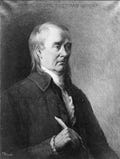




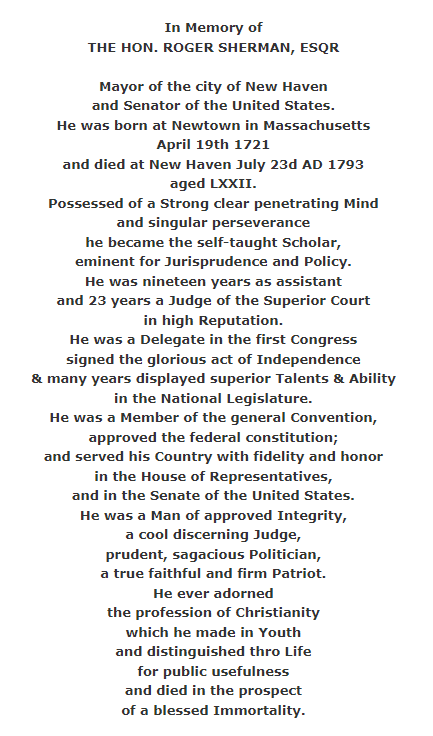
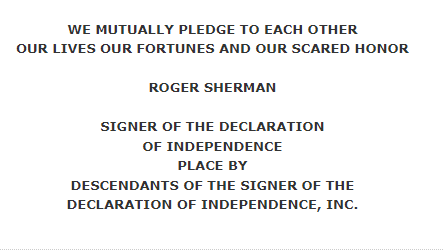
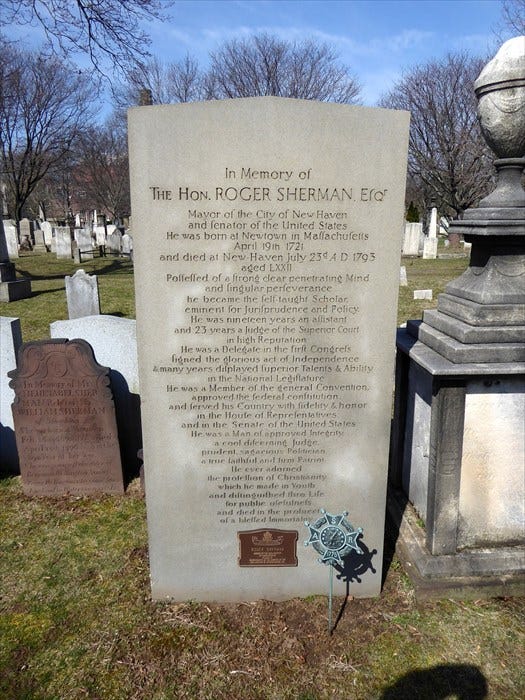

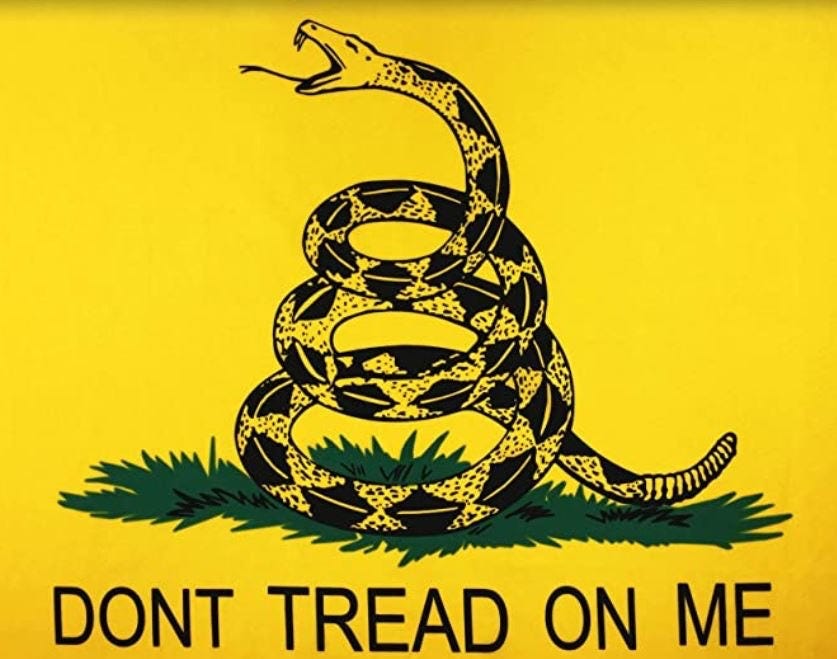
Home grown strength like this is rare now. We are now partly depending on immigrants to defend us. If Musk single-handedly preserves free speech, it will be as important as the Berlin Wall’s fall. I’m guardedly hopeful.
—robertyoho.substack.com